- About Archives
- About SAA
- Careers
- Education
- Publications
- Advocacy
- Membership
Dear Colleagues:
The New Year has begun as I write this letter. It’s hard to believe that it’s 2012.
Our section meeting in Chicago was well attended and I think everyone enjoyed and learned from the presentations by Jackie Espisito and Michelle Belden from Penn State University and Jennifer Gunter King from Mount Holyoke College. We are working on making these presentations available for members of the section.
At the meeting we welcomed our new Vice-Chair/Chair Elect, Alison Stankrauff, and new Steering Committee members, Daniel Hartwig, Kate Donovan Jarvis, Katie Nash and Pat Webber. We thanked Tamar Chute, the outgoing Chair for her great work as well as the outgoing Steering Committee members, Chris Prom and Jay Gaidmore. Tamar also announced that Michelle Sweetser would be replacing Christopher Laico as Newsletter Editor and thanked Christopher for his past service to the section. I invite you all to review the minutes of that meeting included in this newsletter. Please let me know if there are any comments or questions.
The Steering Committee reviewed 11 proposals for endorsement for the 2012 meeting in San Diego. Two proposals were recommended to the Program Committee and we’ve just been informed that the session proposal entitled “Removing Borders: Towards Seamless Connections Between Born-Digital and Hard-Copy Records” was accepted. Congratulations to the folks who put that proposal together. I for one look forward to attending that session at the annual meeting.
In early December I submitted the section’s annual report to SAA Council. In the section “Ongoing Project/Activities” I noted that a subcommittee of the steering committee has been tasked with reviewing the recommendations put forward by a 2010 subcommittee on the C&UA section newsletter and website. These recommendations were reported in the Winter 2011 issue of the newsletter. Alison Stankrauff is leading the current group which includes Jay Gaidmore (member of the 2010 committee), Michelle Sweetser (Newsletter Editor), Daniel Hartwig (current Steering Committee member) and Claude Zachary (Web Liaison). Thanks to this group for working on this important project.
Another issue that I will be taking to the Steering Committee for their consideration is the 2005 version of the Guidelines for College and University Archives first published in 1999. Council did not approve the 2005 version. A suggestion has been made to reframe it in terms of “best practices”.
One of the items that section chairs are asked to address in their annual report to Council are diversity initiatives undertaken during the year by the section. As a reminder diversity is one of the three strategic priorities identified by SAA. I would be interested in hearing ideas from the membership about ways that our section can contribute to the greater effort. Please feel free to contact me at any time about this or any other issues that you would like to see the section address.
Best wishes,
Becky Schulte
Chair, College and University Archives Section
Minutes from the section's annual meeting (August 25, 2010) have been posted to the C&U website.
The University of Wisconsin-Milwaukee (UWM) Archives Department is pleased to announce the opening of the James Liddy Papers. The collection contains the writings of a world-renowned poet and former UWM professor.
James Liddy was born in Ireland in 1934. After earning his Master’s degree in English in 1959, he attended law school. However, poetry was never far from his mind, and he soon turned to his passion instead. He began studying under Patrick Kavanagh and was influenced by other writers like James Joyce, Charles Baudelaire, and Jack Kerouac.
In 1963, Liddy co-edited the literary magazine Arena in Dublin. Only four issues were produced, but it still became a well known publication in Ireland. Years later, after arriving at UWM and much to his surprise, Liddy learned that the UWM Archives had purchased the Arena files in 1966, which are also open for research.
Soon after the end of Arena, Liddy began to travel, first to Spain, and eventually making his way to San Francisco in 1967. Once there, he began a career in teaching that would span 40 years. In 1976, Liddy joined the faculty of UWM, teaching classes such as English, Beat Literature, Creative Writing, and Irish Literature for over 30 years.
He also continued to write, and rather than being influenced, he became an influence, particularly to his students. A former student wrote to Liddy and thanked him for “encouraging the poetic insights within my soul.” And the poet John Ashbery described Liddy as “one of the most original among living Irish poets.”
Writing prolifically, Liddy contributed articles, reviews, and poems to numerous periodicals. Over 30 books and chapbooks of poetry bear his name. Some of his better known works include In a Blue Smoke (1964), Baudelaire's Bar Flowers (1975), A White Thought in a White Shade (1987), Collected Poems (1994), and The Doctor’s House (2004).
The collection contains correspondence, photographs, publications, notes, and drafts of his works in progress. There are also several unpublished works, including a novel. Liddy passed away in 2008. A guide to the collection is online.
Submitted by Bob Jaeger, Project Archivist
The Mount Sinai Medical Center Archives has opened the papers of Dr. Albert S. Lyons (1912-2006). This collection will be of interest to scholars in many areas of medical history. A gastric surgeon, Dr. Lyons established the Intestinal Rehabilitation Clinic at The Mount Sinai Hospital and was Clinical Professor of Surgery at Mount Sinai School of Medicine. He chaired the Medical Society of the State of New York’s Ad Hoc Committee to Study Professional Medical Liability Insurance. An early advocate of patient self-help, he helped organize a support group for ostomy patients at Mount Sinai, the first such group of its kind, and the United Ostomy Association (UOA), a national umbrella organization. He served for many years as the UOA’s Medical Advisor. He was also a historian of medicine who wrote on medical history’s relationship to medical education; in 1978 he published Medicine: An Illustrated History (New York: Harry N. Abrams, Inc.) a lavishly illustrated volume.
His papers contain 13 linear feet of material, including correspondence, project files and the records of various organizations. Approximately half the collection consists of records related to ostomy groups and ostomy care, including the administrative records of the UOA and several regional ostomy clubs. It includes a file of periodicals issued by groups throughout the country that contains near-complete runs of several newsletters; international ostomy groups are also represented, as are publications by vendors of ostomy-related products and an assortment of other literature on ostomy self-help. A finding aid is available.
Submitted by Nicholas Webb, Assistant Archivist
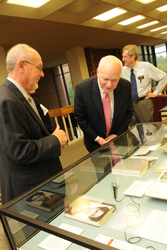 In April 2011, the Brian P. Lamb Booknotes Collection was donated to the Special Collections & Archives unit of George Mason University Libraries by Mr. Lamb. The collection contains 801 books all of which were read by Lamb for research and to prepare for interviews with their respective authors for his weekly C-Span series Booknotes. Many of the books in the collection have extensive marginalia and other notes made by Lamb during the research process.
In April 2011, the Brian P. Lamb Booknotes Collection was donated to the Special Collections & Archives unit of George Mason University Libraries by Mr. Lamb. The collection contains 801 books all of which were read by Lamb for research and to prepare for interviews with their respective authors for his weekly C-Span series Booknotes. Many of the books in the collection have extensive marginalia and other notes made by Lamb during the research process.
The University Libraries celebrated the new acquisition with an exhibit and reception on September 21st. The exhibit, “Beyond the Book: An Exhibition of the Brian Lamb Booknotes Collection,” displays marginalia and other interesting items found in the collection of books as well as selected excerpts from Lamb’s interviews with various authors. The goal of the exhibit was to capture Lamb’s engagement with the books and the content of the interviews more so than to highlight content of specific books. What is so unique about this collection is that it lends insight into how Lamb structured his interviews and interpreted the different works. It’s truly a valuable resource for students and researchers who conduct interviews themselves. A digital component of the exhibit can be viewed online.
Brian Lamb is the founder and chief executive officer of C-SPAN. Lamb has served as the company’s CEO since its beginning in 1979.
The program, Booknotes, officially began on April 2, 1989 with an interview of Zbigniew Brzezinski about his book, The Grand Failure, but its roots were in a series of interviews conducted by Lamb and shown on C-SPAN in September and October 1988. The show format was quite simple. Lamb and his interview subject were seated on a dark empty set with sparse lighting. The cameras focused primarily on the author, and only rarely did we see the interviewer.
In total Booknotes comprised 801 interviews and ran from 1989 to 2004. It focused primarily on contemporary nonfiction books, save for one title, Say Cheese, by Vasily Aksyanov, which was the only fiction novel included on the show. With Booknotes C-SPAN established a popular television forum for writers of history, biography, politics, and public affairs. Lamb is currently host of a new interview series on C-SPAN entitled Q&A.
Submitted by Leah Donnelly Richardson, Research Services Coordinator
The Digital Collections and Archives (DCA) at Tufts University is pleased to announce the completion of its TAPER Project (Tufts Accessioning Program for Electronic Records). During the project the DCA designed, developed, and implemented machine-readable submission agreements and records context records. The DCA fully implemented the machine-readable submission agreements to document accessions and integrated the production of records context records encoded in EAC-CPF into its normal descriptive practices. By the end of the grant project the DCA encoded 51 records context records about Tufts departments and offices in EAC. The EAC records can be viewed online; the project website is available as well. Part of the project deliverables include the DCA's local instructions for implementing EAC; all project deliverables are online and available to use, adapt, and modify.
TAPER was funded by the National Historical Publications and Records Commission as an electronic records Program Expansion Project grant.
Submitted by Eliot Wilczek, University Records Manager and Veronica Martzahl, Records Archivist
The Indiana University South Bend Archives was part of a team that received four grants in Spring of 2011 that will enable the creation of the South Bend African American Civil Rights Landmarks Tour.
The tour will include a total of eighteen sites through the city of South Bend, Indiana that speak to the history of the city in general, and to the city’s African American history in particular.
The tour is an initiative of IU South Bend’s Civil Rights Heritage Center, which is a partnership between students, faculty, staff, and community members to honor area social justice activism and activists past, present, and future. As the Center’s Mission Statement puts forward:
Inspired by the study of the Civil Rights Movement, students at IU South Bend founded the Civil Rights Heritage Center to record, preserve, and celebrate the struggles and extraordinary achievements of citizens committed to social justice. In partnership with schools, community organizations, neighborhood centers, and local government, the Civil Rights Heritage Center uses local and national civil rights history to promote social justice through individual responsibility and improved race relations.
The IU South Bend Archivist, Alison Stankrauff, is active with the Center, serving as the Center’s Archivist, on the Center’s Board, and on several committees for the Center, including its Oral History Committee, Collections Committee, Grant Writing Committee, and two student scholarship committees.
The Civil Rights Heritage Center envisioned a tour throughout the city of South Bend that would make the stories of local African American history and activism known and accessible. The Center partnered with the Northern Regional Office of the Indiana Landmarks and the Northern Indiana Center for History to apply for grants to create a tour to document and explain African American landmarks in the city of South Bend.
The tour will include eighteen sites throughout South Bend that elucidate the key people and institutions and the parts they played in community activism and life. The locations will be indicated with a marker that has a short history of the significance of the site locally – with some contextual information on the site to concurrent national civil rights history.
The Tour will begin at the Civil Rights Heritage Center’s Natatorium, the home of the Civil Rights Heritage Center, just west of downtown South Bend, with the site locations being walkable from there.
The seventeen additional sites include:
Three grants totaling approximately $10,000 were awarded by the National Trust for Historic Preservation through their Partnership-in-Scholarship Fund for African American Historic Places, the National Endowment for the Humanities, the Ford Foundation, as well as the Indiana Humanities Historic Preservation Education Program with partial funding provided by Indiana Landmarks’ African American Heritage Fund.
Scheduled for completion in Spring 2012, it is hoped that the South Bend African American Civil Rights Landmarks Tour will be a point of pride for the city and for the greater area – and encourage people to learn about the community’s compelling African American history and stories of civil activism.
Submitted by Alison Stankrauff, Archivist and Associate Librarian
A consortium of four public and private university libraries in Oregon (Western Oregon University, Pacific University, Portland State University, and Willamette University) have set long-term goals for cooperatively identifying, soliciting, processing, preserving, and making available online materials related to the non-official and personal papers of Oregon governors since World War II. Building on a previous LSTA grant, these institutions were awarded a LSTA implementation grant in the amount of $68,000 to cooperatively process the non-official and personal papers of Oregon governors. The Cooperative Governors’ Papers Project will include the papers of recent governors Barbara Roberts (Portland State University), Victor Atiyeh (Pacific University), and Robert W. Straub (Western Oregon University). The grant will provide funding to hire a travelling project archivist to physically process the papers of three gubernatorial personal collections using collaborative guidelines and standards. These collections will be described through multiple access points, including finding aid submissions to Northwest Digital Archives. Materials will also be identified for future digitization projects. The project will produce processed gubernatorial personal collections that illustrate Oregon’s unique governance system and its workings, including the impact of its political, environmental, legislative, gubernatorial, and educational leadership. Recent scholarship demonstrates the need for further processing of these collections, with two recent and forthcoming publications from OSU Press, an autobiography by Governor Barbara Roberts and a forthcoming biography of Governor Robert W. Straub by Chuck Johnson.
Submitted by Erin Passehl, Archivist
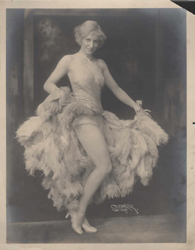 The Gertrude and Max Hoffman Papers provide a look into the life of two influential artists in the first half of the twentieth century. As one of the first female dance directors in vaudeville and Broadway, Gertrude Hoffman’s collection of newspaper clippings, scrapbooks, photographs, music, notes, and correspondence supports research into the day-to-day details of performing and directing dance and theatre productions. Max Hoffman’s music manuscripts and personal music library provide a resource for both the type of original music that was being written at that time and how it related to and incorporated more traditional, classical music. Personal notebooks and family photographs also provide a more intimate glimpse into the life of the couple. There are newspaper clippings, photographs, music manuscripts, personal correspondence, performance notes, programs, publications, and performance posters. The majority of the collection centers around publicity, music, and notes from The Gertrude Hoffman Girls, with a smaller but substantial amount of material from Gertrude Hoffman’s own performances as well as personal family records.
The Gertrude and Max Hoffman Papers provide a look into the life of two influential artists in the first half of the twentieth century. As one of the first female dance directors in vaudeville and Broadway, Gertrude Hoffman’s collection of newspaper clippings, scrapbooks, photographs, music, notes, and correspondence supports research into the day-to-day details of performing and directing dance and theatre productions. Max Hoffman’s music manuscripts and personal music library provide a resource for both the type of original music that was being written at that time and how it related to and incorporated more traditional, classical music. Personal notebooks and family photographs also provide a more intimate glimpse into the life of the couple. There are newspaper clippings, photographs, music manuscripts, personal correspondence, performance notes, programs, publications, and performance posters. The majority of the collection centers around publicity, music, and notes from The Gertrude Hoffman Girls, with a smaller but substantial amount of material from Gertrude Hoffman’s own performances as well as personal family records.
Ranging from 1900-1956 and encompassing 15 linear feet, the materials include music manuscripts and theatrical memorabilia of Gertrude and Max Hoffman, famous vaudevillian and performing arts figures. Gertrude Hoffman was known as a vaudevillian, mimic, dancer, and the director of The Gertrude Hoffman Girls. Max, one of the first arrangers to use ragtime rhythm, was a composer and musical director. The collection (1900-1956) includes music manuscripts, programs, photographs, playbills, notebooks, newspaper clippings, and scrapbooks.
The Gertrude and Max Hoffman Papers are open for research Monday through Friday from 9AM to 5PM, at the Wake Forest University Z. Smith Reynolds Library, Special Collections and Archives Reading Room, Winston-Salem, NC. A finding aid is available online.
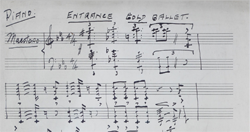 The Gertrude and Max Hoffman Music Manuscript Collection is now available online. With 170 titles represented in various levels of completion, we anticipate this collection to be a delight to musicians, composers, and anyone interested in vaudeville orchestration.
The Gertrude and Max Hoffman Music Manuscript Collection is now available online. With 170 titles represented in various levels of completion, we anticipate this collection to be a delight to musicians, composers, and anyone interested in vaudeville orchestration.
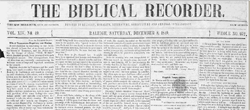 The Wake Forest University Special Collections and Archives department is pleased to announce that the Biblical Recorder microfilm is now online and searchable! Thanks to a grant from the Institute of Museum and Library Services under the provisions of the Federal Library Services and Technology Act (LSTA) as administered by the State Library of North Carolina, a division of the Department of Cultural Resources, our issues of the Biblical Recorder from 1834-1970 were digitized, made searchable, and put online. This resource is one of our most highly used collections, and we are proud that it is now more accessible.
The Wake Forest University Special Collections and Archives department is pleased to announce that the Biblical Recorder microfilm is now online and searchable! Thanks to a grant from the Institute of Museum and Library Services under the provisions of the Federal Library Services and Technology Act (LSTA) as administered by the State Library of North Carolina, a division of the Department of Cultural Resources, our issues of the Biblical Recorder from 1834-1970 were digitized, made searchable, and put online. This resource is one of our most highly used collections, and we are proud that it is now more accessible.
The Biblical Recorder is the official journal of the North Carolina Baptist Convention. Thomas Meredith, and early pastor who was instrumental in the formation of the state convention, founded the newspaper under the name of the Baptist Interpreter. The name was soon changed to the Biblical Recorder and Journal of Passing Events, and ultimately shortened to the Biblical Recorder. Readers can trace trends in social, cultural and religious views from 1833 until now, and gain a better understanding of how Baptist practices and attitudes have changed over the years.
For more information, please contact Special Collections & Archives at the Z. Smith Reynolds Library, Wake Forest University.
Submitted by Rebecca Petersen, Access Archivist
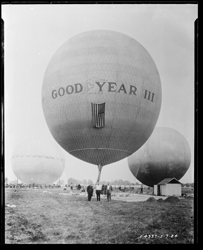 Thousands of historic images from the Goodyear Tire & Rubber Company are now available online through The University of Akron Digital Resource Commons (UA DRC). The images visually document the fascinating history of one of the world’s largest and most influential rubber companies. Goodyear donated the negatives, which are valued at more than $1.1 million, to UA in 2008.
Thousands of historic images from the Goodyear Tire & Rubber Company are now available online through The University of Akron Digital Resource Commons (UA DRC). The images visually document the fascinating history of one of the world’s largest and most influential rubber companies. Goodyear donated the negatives, which are valued at more than $1.1 million, to UA in 2008.
The collection includes seldom-before-seen images that depict factory scenes, tires and other rubber products, and company events. The images also provide historic documentation of lighter-than-air flight, including blimps, dirigibles, and balloons. Of special note are the early parade balloons first made by Goodyear. World War II era products such as barrage balloons, camouflage airplanes, and inflatable boats are also represented in the images.
The National Endowment for the Humanities (NEH) awarded The University of Akron’s Archival Services, a division of University Libraries, a two-year $303,000 Humanities and Collections Resources Grant in 2010. Since the grant was awarded, the funds have been used to process, preserve, and digitize over 23,000 photographic negatives from the Goodyear Tire & Rubber Company, including the earliest at-risk images (1912-1951) on glass plates and nitrate and acetate film. The Northeast Document Conservation Center in Andover, Massachusetts, digitized 22,500 nitrate and acetate negatives.
The project has been designated a “We the People” project, which is an NEH program designed to encourage and enhance the teaching, study and understanding of American history, culture, and democratic principles.
Archival Services collects, preserves, and makes accessible materials relating to The University of Akron, the history of the Akron area, and other special collections.
Submitted by Emily Gainer, Archives Associate Senior
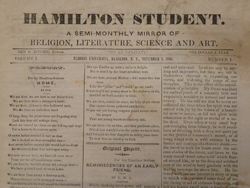 Digital Archive to the Colgate University Student Newspapers (1846-1997) Now Available
Digital Archive to the Colgate University Student Newspapers (1846-1997) Now AvailableSeveral years in the making, the Colgate University Libraries have just completed digitizing its collection of Colgate Student Newspapers for 1846 to 1997. These are among the items most requested by students, faculty, parents, and alumni in the Libraries' Special Collections and University Archives department. They also hold a special place in the history of college newspapers. The Madisonensis, first published in 1868 and now titled Colgate Maroon News, is distinguished as the "first college weekly in America." The first Colgate student newspaper, Hamilton Student: A Semi-Monthly Mirror of Religion, Literature, Science and Art, was founded in 1846 by George G. Ritchie, Class of 1849.
The Libraries’ goal is to provide digital access to the unique and rare items in our collections that have great interest for the Colgate community. This expanded access will help to increase engagement with Colgate by anyone interested in the university and its history as well as to preserve the fragile original physical copies. Also, we are currently working on updating this collection to include the Maroon News for 1998 to 2010 with regular updates added annually.
Submitted by Sarah Keen, Head of Special Collections and University Archivist
The Daily Iowan, the University of Iowa's independent student newspaper since 1868, is now online, the result of a four-year collaborative effort between the UI Libraries and Student Publications, Inc. Researchers may now access the entire 143-year run of the newspaper online. Issues are currently searchable by date; a text-search feature is under development. The collection is part of the Iowa Digital Library, an online repository created from the holdings of The University of Iowa Libraries and its campus partners.
Submitted by David McCartney, University Archivist
The Cuneiform Digital Library Initiative (CDLI), in partnership with the Colgate University Libraries, Special Collections and University Archives (CUL-SC), is pleased to announce the addition of new digital content to its web offerings.
The 48 cuneiform artifacts in the Colgate University Libraries consist of 43 Ur III accounts, four Old Akkadian, and one Old Babylonian text. In June of 2010, UCLA graduate student Michael Heinle scanned the artifacts as part of a digitization mission through upstate New York, and the results of the CUL effort have now been added to CDLI pages (one text could not be located at the time of his visit).
The imaging and image processing were made possible by funding from the Andrew W. Mellon Foundation, and are part of the on-going mission of CDLI to ensure the long-term digital preservation of ancient inscriptions on cuneiform tablets, and, in furtherance of cuneiform research, to provide persistent, free global access to all available text artifact data.
The Colgate University collection of cuneiform tablets was acquired in 1913 by the university’s Semitic Languages Department. Although it is not known for certain from whom the collection was obtained, it is likely that the university purchased the tablets from scholar Carl H. Lager. Lager graduated in 1913 with a Masters degree from the seminary at Colgate University.
Submitted by Sarah Keen, Head of Special Collections and University Archivist